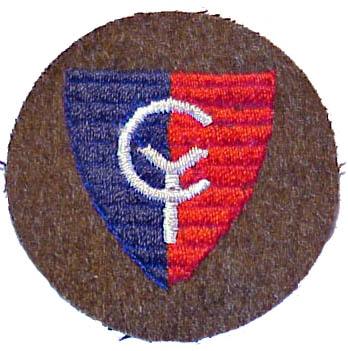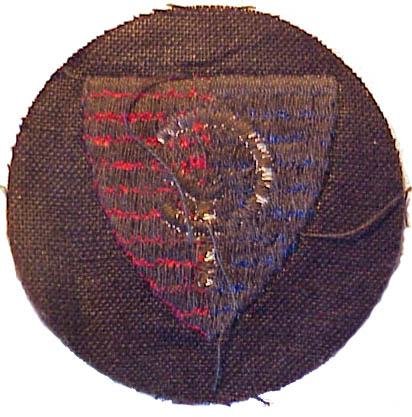American Military Patches, Other Insignia and Decorations of World War Two by Dr. Howard G. Lanham c.2014
Introduction to Patches: Studley Patches
Examples: Courtesy of Hans De Bree
52mm Studley 38th Division
Veteran's Cap Patch

|
|
Back of Same Patch
Note Black Thread

|
|
52mm Studley 92nd Division
Veteran's Cap Patch

|
|
Patches manufactured for and sold by George Washington Studley (1892-1968) are of a unique category. They were basically World War One designs, produced during the 1930s, that were marketed to veterans and not intentionally sold to the U.S. government or active duty soldiers. It does not appear that they were marketed to collectors but there may have been some collectors who acquired them. George W. Studley served in the U.S. Navy both before and during the World War One and was involved with the Bonus Marchers during the Depression. He himself was a collector with a particular interest in medals and often assisted fellow veterans or active duty soldiers with replacement or spare medals or ribbon bars. He was active with veterans groups and enjoyed many contacts across the United States. He often gave lectures on medals and insignia of the Great War to interested groups. He lost his job during the Depression and in 1932 decided to go into the business of selling medals and patches, utilizing his many contacts. He may have sold some original material that he acquired but also reproduced medals and insignia in the quanity necessary to satisfy orders from large groups. His medals were of a high quality and he had a reputation for fair dealing. He originally operated out of Rochester, New York but later relocated to Avon, Livingston County, New York.
The patches he produced cannot be called fakes because he never claimed that they were period originals but they can be called reproductions of World War One designs. Their manufacture is fairly distinct and they constitute a finite series, something any true collection appreciates. Studley produced several catalogs, which illustrated his merchandise. The catalogs are known to have been issued as late as 1945 and perhaps beyond. Just when George W. Studley closed his business is uncertain. Certainly, after the Second World War he got a lot of competition from other companies marketing to collectors, who produced their own different versions of World War One patches. The World One War reproduction patches, both Studley's and those of his competitors, are fairly easy to distinguish from original ones once a person has handled examples of the various types.
According to an article by Phil Hess there were a total of 63 patches that Studley offered in his catalogs. For most units he offered two sizes. There was a small size, typically 52 mm in diameter or just a little over 2 inches that was intended for the sides of veterans’ caps and a regulation size that was typically 74mm or about 3 inches in size. Many but not all of them were round. A few were cut to shapes; for example the 79th division was a shield and 82nd was a square. He did not try to offer the component specific patches that were a characteristic of units such as the Second or 34th Divisions. During the course of his business he used several different manufacturers and as a result the manufacture styles can vary slightly, even within a specific unit. Hess mentions that about half were machine embroidered on olive drab wool. Many of these have black bobbin or “pick up” thread on the back. Some patches were done on black or other colored wool; for example the 77th division was machine embroidered on blue felt. Hess also states that three patches were of felt on felt construction rather than machine embroidery: chemical warfare, general headquarters and armored. The reason appears to be that these particular designs lend themselves to that type of construction. By the time of the Second World War felt on felt construction was uncommon among patches issued by the U.S. military but during the period of the First World War they were common place. His machine embroidered on wool patches might be similar to period ones but for the most part they are distinguishable from true period military insignia. This is particularly true for the 52mm cap patches that stand out because of their small size.
I cannot call these true military patches since they were never intended for or issued to active duty members of the U.S. Armed Forces. However, because some of the manufacture styles and designs are similar to ones that were in use during the Second World War, I felt it important to mention them.
Reference:
- Phil Hess, Studley Veteran's Patches The Trading Post
LX (3):29 July-September 2001
- Melvin Morris, George W. Studley, Father of Modern Military Collecting The Trading Post
LI (1):64 October-December 1991
- Hans De Bree, World War II U.S. Made, Fully Embroidered, Cut-edge Shoulder Sleeve Insignia: A Collector's Guide, Atglen, PA: Schiffer Publishing, 2013, page 235-236
Back to Dating Shoulder Sleeve Insignia
Index to Site
Back to Home Page